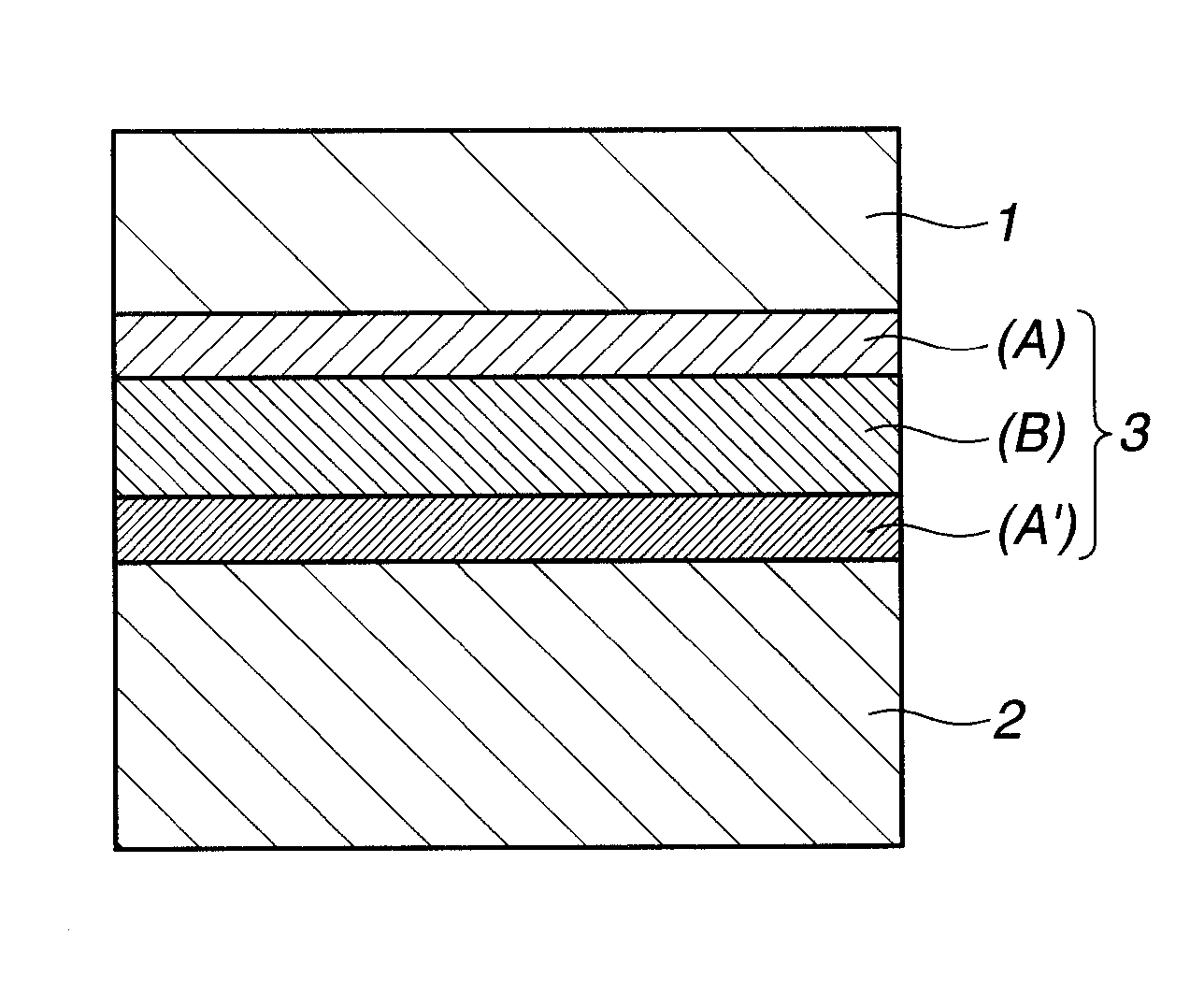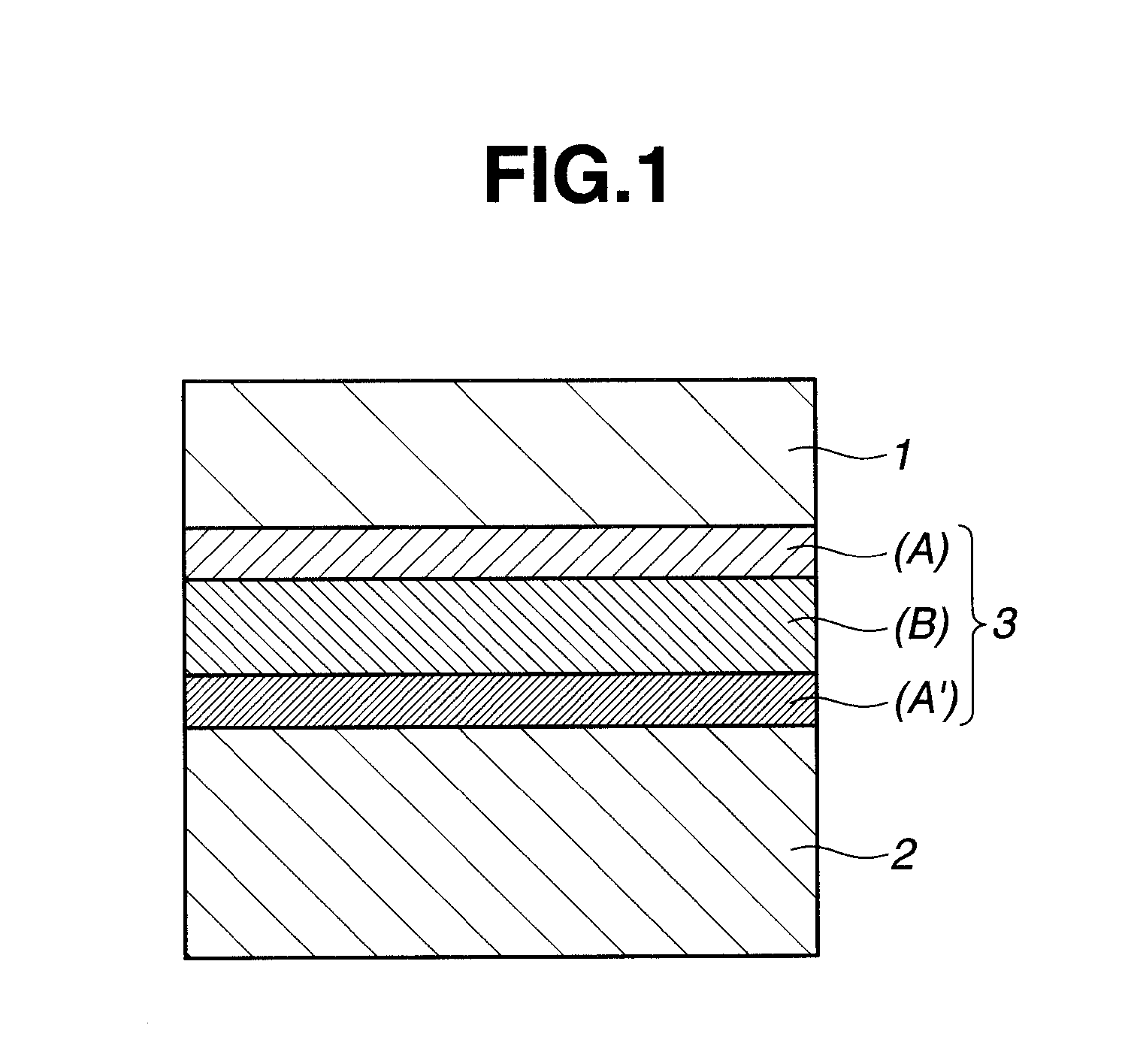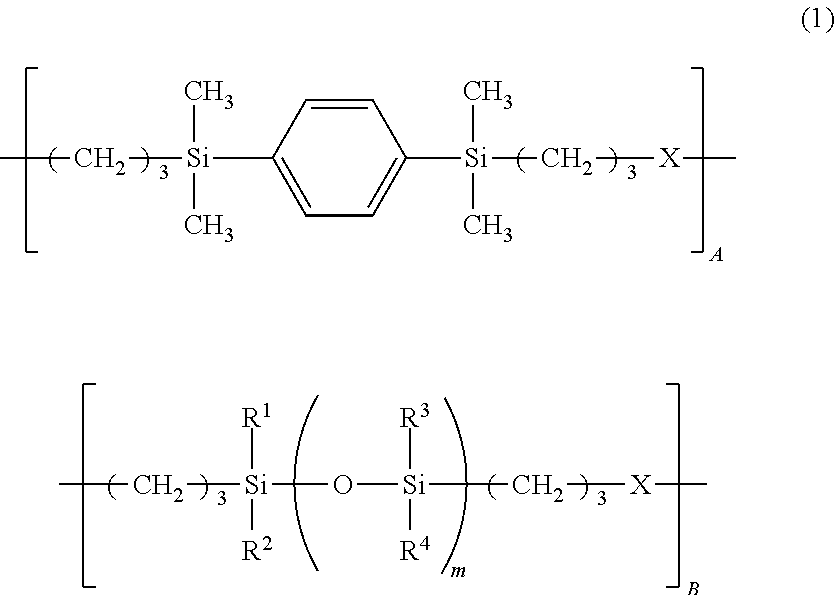Wafer processing laminate, wafer processing member, temporary bonding arrangement, and thin wafer manufacturing method
a technology of wafer processing and wafers, applied in the direction of film/foil adhesives, synthetic resin layered products, transportation and packaging, etc., can solve the problems of insufficient strength and heat resistance to withstand, long time, and expensive tools, and achieve easy manufacturing, high heat resistance, and easy removal
- Summary
- Abstract
- Description
- Claims
- Application Information
AI Technical Summary
Benefits of technology
Problems solved by technology
Method used
Image
Examples
synthesis example 1
Resin Synthesis Example 1
[0067]A four-necked flask was charged with 1,000 g (3.38 mol) of octamethylcyclotetrasiloxane and 0.24 g (0.0015 mol) of hexamethyldisiloxane and heated at a temperature of 110° C. Then, 4 g of 10 wt % tetrabutylphosphonium hydroxide siliconate was added to the flask whereupon polymerization was performed over 4 hours. The product was post-treated at 160° C. for 2 hours, obtaining dimethylpolysiloxane.
[0068]The product was analyzed by 29Si-NMR spectroscopy to determine the contents of D and M units. It was identified to be a dimethylpolysiloxane of the following structure consisting of 99.978% of D units and 0.022% of M units and having a degree of polymerization of about 9,000.
[0069]This dimethylpolysiloxane, 500 g, was dissolved in 500 g of hexane. This was poured into 2 L of acetone whereupon a precipitated resin was recovered. On subsequent removal of hexane in vacuum, there was obtained a dimethylpolysiloxane polymer having a Mw of 700,000 and containin...
synthesis example 2
Resin Synthesis Example 2
[0070]A four-necked flask was charged with 1,000 g (3.38 mol) of octamethylcyclotetrasiloxane and 0.93 g (0.003 mol) of tris(trimethylsiloxy)methylsilane and heated at a temperature of 110° C. Then, 4 g of 10 wt % tetrabutylphosphonium hydroxide siliconate was added to the flask whereupon polymerization was performed over 4 hours. The product was post-treated at 160° C. for 2 hours, obtaining dimethylpolysiloxane.
[0071]The product was analyzed by 29Si-NMR spectroscopy to determine the contents of D, M and T units. It was identified to be a branched dimethylpolysiloxane of the following structure consisting of 99.911% of D units, 0.067% of M units, and 0.022% of T units.
[0072]This branched dimethylpolysiloxane, 500 g, was dissolved in 500 g of hexane. This was poured into 2 L of acetone whereupon a precipitated resin was recovered. On subsequent removal of hexane in vacuum, there was obtained a dimethylpolysiloxane polymer having a Mw of 400,000 and containin...
synthesis example 3
Resin Synthesis Example 3
[0073]A flask equipped with a stirrer, thermometer, nitrogen purge line and reflux condenser was charged with 43.1 g of 9,9′-bis(3-allyl-4-hydroxyphenyl)fluorene (M-1), 29.5 g of organohydrogensiloxane having the average structural formula (M-3), 135 g of toluene, and 0.04 g of chloroplatinic acid and heated at 80° C. Then, 17.5 g of 1,4-bis(dimethylsilyl)-benzene (M-5) was added dropwise to the flask over one hour while the flask internal temperature rose to 85° C. At the end of dropwise addition, the reaction solution was aged at 80° C. for 2 hours. Toluene was distilled off, and instead, 80 g of cyclohexanone was added, obtaining a resin solution in cyclohexanone having a resin solid concentration of 50 wt %. The molecular weight of the resin in the solution was determined by GPC versus polystyrene standards, finding a Mw of 45,000. In formula (1), A=0.9 and B=0.1. To 50 g of the resin solution were added 5 g of hexamethoxymethylol melamine (Nikalac MW-39...
PUM
| Property | Measurement | Unit |
|---|---|---|
| temperature | aaaaa | aaaaa |
| temperatures | aaaaa | aaaaa |
| thickness | aaaaa | aaaaa |
Abstract
Description
Claims
Application Information
 Login to View More
Login to View More - R&D
- Intellectual Property
- Life Sciences
- Materials
- Tech Scout
- Unparalleled Data Quality
- Higher Quality Content
- 60% Fewer Hallucinations
Browse by: Latest US Patents, China's latest patents, Technical Efficacy Thesaurus, Application Domain, Technology Topic, Popular Technical Reports.
© 2025 PatSnap. All rights reserved.Legal|Privacy policy|Modern Slavery Act Transparency Statement|Sitemap|About US| Contact US: help@patsnap.com



